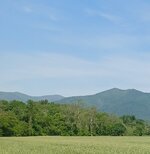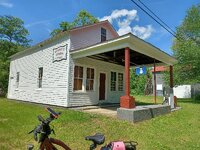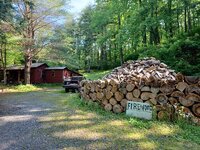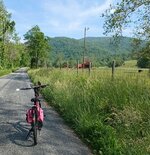It's pronouced "hall-er", not "hollow"
While the definition remains the same - a valley between two mountains usually accompanied by a rushing creek, stream, or river - the term pronounced in Appalachian English (also pronounced "App-a-LATCH-un
", while outsiders known as "city folk" tend to pronounce it "App-a-LAY-shun") takes on a whole new meaning of mountain life. If you're gonna ride your bike in the mountains, better be prepared to speak the lingo.
View attachment 123937
View attachment 123942
View attachment 123943
Not that Madison County in central Virginia is the bastion of all things Southern, but it is far enough south of Washington DC to give an honest nod to the uniqueness that is part and parcel of an entire culture recognized by a particular twang in the speech and an embrace of lives lived in secluded woodland valleys tucked among ancient mountains. To ride a bike along these roads is to indulge in a feast for the senses.
View attachment 123938
However, yesterday's "feast" took place under the wretched himidity of a sweltering heatwave reaching into the low 90s(F not C). 384 cyclists, in varying degrees of readiness, tackled any one of 3 distances - a metric century, a 42 mile, and a 20 mile - for the "Tour de Madison" charity ride.
I opted out of my planned 42 mile ride because of the heat and settled comfortably into the more "family friendly" 20 mile route (read this as "flatter roads winding almost exclusively under the much welcomed shade of heavy woodland forests") that kept a smile on my face and kept sunburn at bay. I was not alone, either. From the bevy of passing cyclists criss crossing our paths on the three in-and-out "arms" of the 20 mile route, we were one and all glad to have opted for the shaded scenic route. Each arm of the route was accompanied by its own set of clear mountain streams, all bubbling and churning in a mad rush to get downstream to be rid of the excessive volume of water dumped on the local tributaries by the recent heavy rains. I noticed that while the paved roads tended to be oriented somewhat straight on a fairly civilized set of standards, the adjacent tumbing creeks took their own initiative, rushing a wild zig-zag slalom over rocks and boulders, occasionally venturing close enough to the unsuspecting road to surreptitiously sneak a handful of dirt here and there from the road embankment and wash the perloined real estate downstream with no one the wiser. Now and then a visually ugly huge dump of rock and boulders by the road crews down the steep shoulders between creek and road showed the Department of Transportation's attempts to reclaim some of the stolen real estate when too much blatant riparian thievery threatened to undermine the entire road.
For the most part the roadside streams were well behaved, and passageways spanning one side of the hollow to the other over the vast network of coursing water took on quite the spectrum of utility vs. aesthetics. Some spans were earmarked specifically for human traffic while the cars and trucks were relegated to splash their way to the other side.
View attachment 123935
View attachment 123934
Some spans over deeper creeks offered a vehicle option, but safety, for some reason, appeared secondary. Rotted, broken, and missing wooden bridge pieces were dutifully ignored by this one hollow resident on his homemade egress. I wouldn't have the courage to trust my car over this questionable structure to save my soul. I barely trusted it to hold my bike while I took this photo.
View attachment 123936
One particular arm of the route sent the cyclists up a narrow country road, very beautiful and very peaceful and exquisitely shaded, but for some as yet unknown reason the roadside trees suddenly began being peppered with ubiquitous No Parking signs. The type of inner city signs sporting a large P encircled in red with a slash across the typeset. Not what I expected to see in the mountains, and it piqued my interest as the signs became increasingly more hostile and numerous, decorating trees on both sides of the road until abruptly they ended at this sign:
View attachment 123939
Private lands and the No Parking signs obediently gave way to a rather narrow and smallish public parking lot at the fringe of this park entryway. I stopped my bike behind a car whose occupant was busy discussing logistics with a park ranger. I overheard the conversation concerning the fact that this parking lot was now full and the need, next time, for said motorist to "get here before 10am" if they wanted a place to park. "The best you can do", the ranger explained, pointing back down the road we had both traversed, "is to turn around and go down the road to one of the properties that has private parking. It'll cost you $10". The ranger set a "Lot Full" sign firmly in the middle of the road and walked off. There was nothing the motorist could do but manage a tight turnaround and go back to seek parking elsewhere.
Sure enough, the enterprising landowners whose property adjourned the parkland had set up their own "pay and park" businesses to cover the overflow of cars unable to find any free parking at the trailhead. The arm of this section of my route had ended at the park and returned me back down the same road. I stopped to snap a shot of one unusual tree decoration that I'd probably never see anywhere other than in Appalachia - an ancient rotary lawn mower tacked to a tree.
View attachment 123940
By luck a young lady dressed in quite the official high-viz traffic vest, probably to appear as professional as possible as a modern "highwayman" lightening the purses of the motorists desperate enough to pay usury for a temporary bit of ground to park a car, happened to be nearby when I took the picture. I politely inquired as to why the lawn mower was tacked to the tree, and she smiled. "It was my great-great-great-great (at this point I lost count of the greats) uncle's", she said, which still gave me no clue why it was tacked to the tree. "He used to live here," she explained, nodding over her shoulder to the small well worn cottage surrounded by a garden of mismatched statuary behind her.
View attachment 123941
She lived here now, she said, and with enterprising acuity she had taken advantage of her small bit of property to do a respectable bit of highway robbery in the form of offering $10 parking privilages for motorists faced by an already full free parking lot at the trailhead. Six or so motorists had already been fleeced and had left their cars to her care. She was very sweet so I wished her well and hoped she'd get lots of business. "I hope so, too, mam", she said earnestly, looking up the road at the growing number of cars lining up at the trailhead that would potentially be customers for her enterprise. "I can use the money".
My journey back down the road passed by another property, this one bigger for more "overflow cars", still charging the outrageous fee of $10. The couple sitting in the gator at the entryway to the property were not inclined to return my wave hello, but glared at me as I cycled by if I was some type of freeloader who had no use for their services. Which I didn't. $10 to park your car and walk a quarter mile to the park border was beyond the pale. I left the later day highwaymen behind and pedaled on.
The close proximity to the national park offered quite a variety of business opportunity, none the less for the imaginative to run a bit off center. I don't know in what universe these "luxury cabins" would come close to being anything other than a glorified Mongolian hut, but here we are. The sign was attached to an old feed hopper which also gave me pause. I had no idea how to process this. None at all.
View attachment 123944
I did quite like the name of this store and given a bit more time would have loved to have toured it's interior full of oddities. Maybe next time.
View attachment 123945
The route continued on, providing a wealth of entertainment in the stunning surroundings. Despite the need to keep pedaling to get a cool breeze in the building heat and humidity, I found myself unable to resist stopping countless times for photos, especially the one below which I fancied looked a whole lot like a redneck's idea of a commuter parking lot.
View attachment 123957
Turns out it was a parking lot for a local fishing hole. A young man and his lady companion were just exiting the stream to pack their fishing gear in their car trunk. I called out asking how the fishing had been. The young guy answered he'd caught one. He nodded to his smiling female companion. "She caught three," he said. I gave her a thumbs up and a hearty congratulations. She grinned even broader, one hand holding her fishing rod while the other hiked up her long pants against the force of gravity and the sopping wet fabric from the calves down. She couldn't have been happier. No fish in view so they must have let their catch go. I returned their friendly goodbyes and continued down the road.
View attachment 123946
View attachment 123951
At one intersection of the route where once a thriving mercantile center had plyed its trade, a quiet reminent of the past stood patiently off the road. The building was old, I could see that immediately, but had been graced with a new coat of paint recently, and awarded a sign to proudly display it's former heritage. It was firmly closed with no intention upon returning to life anytime soon. Nor did it have anything to say for itself beyond the sign on the wall.
View attachment 123960
I had to wait to get home and jump on the internet to discover the building dated back to 1936 and was once owned by Gideon Weakley as the general proprietor. For the next 30 or more years the building housed a thriving enterprise comprised of general goods and groceries. Countless family members, cousins, neighbors, and friends passed through the once open doors. The store remained in the family as the years progressed, with only the old gas pump hinting the business had closed down in the late 50's/early 60s when fuel was dispensed at a whopping 29 cents a gallon and where you could add your own additive for higher octane. The good old days indeed
View attachment 123949
The building been sold in 2018 by the widow of the prior owner's remaining son who had died the year before at the age of 88. The window died a year later after the sale of the building, ending over 70 years of the same family ownership.
I left the old relict behind, hoping that one day it might come back to life again as a museum dedicated to the life and times of the community in the 1900s.
Not too far up the road the route turned onto less traveled, more country like rough pavement patched multiple times over until whatever pavement had been original was now lost under an accumulation of yearly shovelfuls of macadam applications in random spots. One had to carefully watch one's bike tires to accurately dodge and weave among the worst of the road repairs otherwise the teeth-shaking bumps were sheer hell to ride over.
It was along this arm of the route that I passed a rather unique sight. A series of round hay bales had been strategically (and I use that term loosely) placed in a somewhat haphazard pattern in a field, each hay bale surrounded in part by the sort of yellow tape you see at traffic accidents. The kind that has "Do Not Cross" printed endlessly along the entire roll. The traipsing tape was more random than specific, but I guessed it served some purpose. There was a collection of used wooden pallets stacked in a line, and some other debris that was waiting off the end of the overgrown field for some type of employment, but not just yet. As I passed by the field a dune buggy rumbled into view, leading a small parade of two other buggies.
View attachment 123953
Even from a distance I could see the noisy machines were decked out in an overabundance of colorful decals often only found at racetracks and backyard junkyards. The dune buggies were headed towards a large pop-up tent midfield where a few more dune buggies were parked. It wasn't until I rounded the corner of the road that I discovered just what was taking place.
View attachment 123952
I did stop for a moment when two dune buggies crossed the road ahead of me and parked close enough for me to wave to one of the drivers. It was a kid, about 10 or so, dressed in a storm trooper outfit with an oversized helmet that completely obscured any trace of human features. The helmet faced me as I called out asking if this was a competition. A small youthful voice came out of the helmet in a one syllable answer. "Yes". The pintsized figure stood silently as I asked if there were prizes or points awarded. Again, a one syllable answer emerged from the recesses of the oversized helmet. "Yes". The still form listened politely as I asked if he (assuming it was a male - the clothing and face-obscuring helmet made it impossible to tell) was competing. Another monosyllabic answer. "Yes". I was beginning to think this kid had taken the "danger stranger" warning now being instilled into all grade school children too much to heart. There was zero chance for any sort of meaningful dialogue or exchange of info, so I decided to give the kid a break and simply wish him (her?) well in the competition. This time two syllables emerged from the oversized helmet. "Thank you". The small figure, now released from any more social obligations to this random stranger on a bicycle, turned and followed his companion who was now completely out of view. I watched the retreating figure and thought "he forgot to say 'mam'". His own mother would be most disppointed at his lack of southern courtesy to a lady. I decided it was probably the helmet's fault. That thing was way overkill. Probably heavy as sin, too, pressing down on that poor kid's brain.
I remounted my ever patient bike and continued on down the road
In a short time the route had swung me a full 21 miles through the delightfully entertaining countryside, bringing me full circle back to the parking area where cyclists of the various divisions were now returning in drips and drabs back to their cars. Some looked exhausted, the heat by then was oppressive. My husband, who had been happily ensconced on a comfy lawn chair, reading in the shade by the main creek running through the parking area, told me with a grin that he watched one cyclist walk past, lean his bike against a conviently placed nearby picnic table, march straight into the cold rushing creek, and lay down! Shoes and all. Yeah, it was that hot.
Ride now complete it was time to partake of the pulled pork and chicken barbecue set out for the returning riders, pick up the ride t-shirt, thank the volunteers, and park ourselves at one of the picnic tables next to the stream to enjoy the free lunch. A long distance cyclist, Chris Register, who had written
two books on his travels around the United States had set up a table nearby selling his books. I stopped to chat with him and buy Book #1 to read.
View attachment 123962
A delightful fellow with an equally delightful blue merle Border collie/Aussie mix companion whose zest for playing fetch with a fuzzy ball showed no limits even in the oppressive heat. I petted the sweet head of the sweet dog while chatting with his author owner. Book #2 could be purchased through his website I was told. I promised to let Chris know how I enjoyed his published tales of the road.
And then it was time to pack up the bike on the rack, load the car, crank up the AC, and head the 75 miles back home where gas prices are coming close to matching the price of a highwayman's parking fee. Back north where a hollow is a hollow and Appalachian English is simply a Wikipedia entry.
The real thing, however, is priceless. Well worth the 150 mile round trip to ride for 20 miles in the gorgous mid-Appalachian countryside.
View attachment 123956





